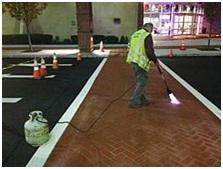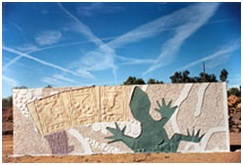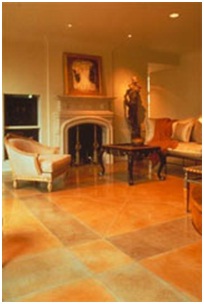





Published on Nov 30, 2023
Decorative concrete is the use of concrete as not simply a utilitarian medium for construction but as an aesthetic enhancement to a structure, while still serving its function as an integral part of the building itself such as floors, walls, driveways and patios. The transformation of concrete into decorative concrete is achieved through the use of a variety of materials that may be applied during the pouring process or after the concrete is cured, these materials and/or systems include but are not limited to stamped concrete, acid staining, decorative overlays, polished concrete, concrete countertops, vertical overlays and more.
Stamped Concrete is the process of adding texture and color to concrete to make it resemble stone, brick, slate, cobblestone and many other products found in nature including wood, fossils, shells and many more. This limitless array of possibilities combined with great durability and lower cost than natural products makes Stamped Concrete an easy choice for new construction and renovation projects.
The installation consists of pressing molds into the concrete while the concrete is still in its plastic state. Color is achieved by using Dry Shakes or Color Hardeners, Powder or Liquid Releases, Integral Colors or Acid Stains. All these products may be combined to create even more intricate designs.
Stamped Concrete may be used on driveways, patios, commercial roads and parking lots and even interior floors. Stamped concrete is a desirable finish to concrete areas, however with time and wear the color dyes fade and the surface looks patchy and unpresentable. There are many re-coloring options which can completely restore and rejuvenate the color and presentation of faded stamped concrete.
Concrete "dyes" take many different forms and compositions and can be used on both residential and commercial concrete applications, including sound/retaining walls, bridges, countertops, floors,[1] etc.
Early concrete dyes consisted of generic printing inks that were dissolved in mild solutions of alcohol and applied to concrete surfaces to add a wide array of color to plain gray concrete. When alcohol-based dyes are exposed to sunlight, the color either lightens or fades out completely. Therefore, alcohol-based dyes were more prevalent in interior applications where direct sunlight or other forms of ultraviolet (UV) lighting was not present.
Manufacturers later began dissolving the same printing inks in different carriers, such as acetone, lacquer thinner and other solvents, hoping to achieve increased penetration levels. In addition, UV inhibiting agents were added to new dyes to help with the UV instability issues. However, slight fading (5-8% per year) still occurs when the dye is exposed to direct sunlight.
Colored concrete can be obtained from many ready mix concrete companies and many have color charts available.
Acid staining is not a dyeing or pigment-base coloring systems, but a chemical reaction. A mixture of water, mineral salts and a slight amount of muriatic acid is applied to the concrete surface. This chemical reaction with the existing minerals (primarily lime) in the concrete over a period of one to four hours creates new earth tone colors on the concrete surface. The concrete surface is later scrubbed to remove excess stain and neutralized by a basic solution of ammonia and water or baking soda (less likely to cause whiting later) to help raise the ph level back to normal level. Due to inconsistencies in the surface level of concrete floor, acid staining creates a variegated or mottled appearance that is unique to each slab. The color penetration ranges from 1/16 to 1/32 of an inch. Older exterior concrete surfaces may not color as well as interior surfaces because the environment has leached or percolated out the mineral content. As well, any exposed aggregate (rocks) in worn concrete will not accept staining.
Chemicals commonly used in acid staining include Hydrochloric acid, Iron chloride and Sodium bicarbonate.
Water Based Stains are similar to acid based stains in the sense that one can still achieve a translucent look like acid; some stains are able to achieve an opaque color and/or a translucent effect. The main difference is that acid stains react to the concrete and change the physical make up of the concrete material, whereas water based stains are more of a "coating" that bonds with the concrete. There are many variations of water based stains that have come into the decorative concrete industry that perform in a number of different ways. Some are polymer based, acrylic and epoxy.
Concrete overlays date to the 1960s when chemical engineers from some of the larger, well known chemical companies began to experiment with acrylic paintresins as modifiers for cement and sand mixes. The result was a thin cementitious topping material that would adhere to concrete surfaces and provide a newly resurfaced coating to restore the worn surface. Concrete overlays lacked the long-term performance [2] characteristics of acrylic resins. Acrylic resins provided good UV resistance, but lacked long term water resistance and adhesion characteristics needed to provide a long term and permanent solution.
Construction of a polymer cement overlay to change asphalt pavement to brick texture and color to create decorative crosswalk and traffic calming in high-pedestrian area.
Polymer cement overlays, consisting of a proprietary blend of Portland cements, various aggregates and polymer resins, were introduced over 20 years ago. The purpose of adding a polymer resin to the cement and aggregate is to greatly increase the performance characteristics and versatility of conventional cements, mortars and concrete materials. Unlike conventional cement and concrete mixes, polymer cement overlays can be applied thinly or thickly without fear of delamination or typical product failure. In addition, polymer cement overlays are much more resistant to damage from salt, petrochemicals, UV, harsh weather conditions and traffic wearing.
Originally intended for use as a thin surface restoration material for concrete substrates, polymer cement overlays were introduced into the architectural concrete and commercial flooring industries in the early 80s. Subsequently, its use in these industries has become standard. Polymer cement overlays are regarded as economical in providing long term, durable renovation without the need for costly and continuous repairs associated with deteriorating concrete surfaces.
Polymer cement overlays are used for interior and exterior applications ranging from:
• Skim coat/broom finish concrete resurfacing – Restore and protect damaged, pitted, flaking and stained concrete back to the look of a new concrete surface.
• Concrete regrading&leveling – Repair and level concrete surfaces that have settled.
• Existing substrate redecorating and renovating – Alter the appearance of existing concrete or wood substrates through applying "thin stamped" or "thin stained" overlays, creating new textures, colors and designs. For use on commercial or resident pool deck, this frequently takes the form of "splatter textures" or "knockdowns," in which polymer cement is applied to the existing concrete substrate in a moderately textured finish (average of 1/8” thickness) in various patterns. Often, the texture is knocked down with a trowel to slightly modify the appearance and feel of the finished application.
Rubber imprinting tools (stamps) are impressed into thin pre-mixed concrete overlay material shortly after it is placed to create natural stone or brick textures. These rubber imprinting tools are manufactured from molds created from authentic stone or wood. Release agents are used to help release the stamps from the concrete without sticking. Release agents come in either a liquid or powder form and are available in a wide range of colors.
Applied over acid stained, dyes and/or overlays to seal and protect. Some epoxies are also colored
Concrete can be polished with Mechanical grinders and diamond pads of increasing grit sizes. Diamond pads come in many grit or mesh sizes. Common sizes start with 6 grit and can go up to 8500 grit although concrete can only maintain a shine of about 800 grit, it can be helped by adding a concrete hardener such as sodium silicate or lithium silicate which will allow concrete to hold a 1800 through 3000 grit shine. The work is accomplished in multiple stages by passing over the concrete with successive grit diamond pads until it has a hard-glassy finish. Both acid stains and concrete dyes can be used during the polishing process.

Existing concrete can be remodeled by cutting lines and grooves into its surface. Geometric patterns, straight or curved lines and custom designs can be cut directly into the surface of the concrete creating the look of tile, flagstone, cobblestone and many other common surface patterns. This is usually achieved using tools like an angle grinder fitted with diamond blades, but is more effectively accomplished using specialty tools designed specifically for cutting designs into the concrete.
Concrete can also be cast into unique and detailed designs using urethane form liner. These projects can be seen around the United States and the world, usually on sound/retaining walls, building exteriors, and bridges.
Generally, this process starts with the sculptor, who creates the design to be used in the concrete using clay, polyurethane or wax. When the original art is complete, a cast is made using synthetic liquid rubber, and from this cast, form liners are produced in the reverse image of the original.
The form liner then acts as a mold for the concrete to be formed against. Once the concrete is set, the form liner is stripped from the hardened concrete surface. The concrete is permanently textured with the pattern of the form liner.
Concrete is one of the most widely used construction materials in the world. One special subset is called architectural and decorative concrete, which refers to a substance that provides an aesthetic finish and structural capabilities in one. This material is made to be seen. Whether creating broad expanses or minute details, concrete permanently captures the chosen look. Achieving an architectural or decorative appearance usually requires that something different be done to the concrete. Whether that involves special forms, special finishing techniques, or special ingredients, the variety of effects is almost unlimited.

Original art by Carolyn Braaksma, Denver, Colorado
Concrete is one of the most widely used construction materials in the world. One special subset is called architectural and decorative concrete, which refers to a substance that provides an aesthetic finish and structural capabilities in one. This material is made to be seen. Whether creating broad expanses or minute details, concrete permanently captures the chosen look. Achieving an architectural or decorative appearance usually requires that something different be done to the concrete. Whether that involves special forms, special finishing techniques, or special ingredients, the variety of effects is almost unlimited.
White cement concrete is a brilliant architectural material. Whether plain or pigmented, it allows for a broad spectrum of colors - from bright whites and pastels to saturated colors. It can be textured, patterned, or shaped to almost any form, allowing architects to be truly creative in their designs. Imagination becomes architectural reality with white cement.
What makes white cement so architecturally appealing is its versatility. It can be used for:
o Cast-in-place concrete
o Precast concrete
o Tilt-up concrete
o Repair and retrofit applications
o Masonry and mortar
o Stucco finishes
From large to small items, structural to decorative members, white cement is the key to good looking concrete and masonry construction. A versatile appearance allows white cement concrete, which is pigment-friendly, to fit in with any environment. Beyond aesthetics, its light color offers energy efficiency and safety.
These qualities can be used to advantage for:
o Bridge parapets and barrier medians
o Light reflective floors
o Exposed architectural concrete
o City streetscapes: curbs, gutters and planters
o Landscaping
o Building accents
Whether inside or outside, white cement concrete provides a hard-wearing, durable surface that stands up to heavy use.
White portland cement has essentially the same properties as gray cement, except for its color. An important quality control issue in the industry, the color of white cement depends on raw materials and the manufacturing process. Metal oxides, primarily iron and manganese, influence the whiteness and undertone of the material. White cement is manufactured to conform to ASTM C 150, Specification for Portland Cement. Types I and III are the most common, but Types II and V are also produced.
Mix designs for white or colored concrete are formulated with respect to the following ingredients, paying particular attention to the resultant effect on color:
o Type and color of cement
o Type and dosage of pigment
o Type and dosage of chemical admixtures
o Type, gradation, color, and cleanliness of fine and coarse aggregates
o Type and dosage of supplementary cementing materials: calcined clay, slag, white silica fume
o Consistent proportions, especially maintaining a uniform water-cement ratio
It is always recommended to develop a mix design and build sample panels in advance of starting a white cement concrete project. That way, mixtures can be refined and improved and material usage can be optimized. The mockups serve as references for color and surface appearance during the construction phase of the project.
Concrete is one of the most widely used construction materials in the world. One special subset is called architectural and decorative concrete, which refers to cement-based products that provide an aesthetic finish and structural capabilities in one.
These concrete materials are made to be seen. Whether creating broad expanses or minute details, concrete permanently captures the chosen look. Achieving an architectural or decorative appearance usually requires that something different be done to the concrete. Whether that involves special forms, special finishing techniques, or special ingredients, the variety of effects is almost unlimited.

Masonry is one of our oldest, most established building techniques. Evolution in materials, mix designs, and engineering allow for the construction today of even stronger masonry buildings—structures that will last for generations.
Concrete masonry units are available in a rainbow of colors, textures, shapes, and sizes, offering building designers the chance to create structural walls that are also beautiful. Architectural concrete masonry units offer a natural appearance that is striking in urban applications, and blends in with the natural beauty of rural areas—always complementing the building’s surrounding environment.
Stucco, or portland cement plaster, is a versatile facing material that can be applied to flat or curved surfaces either inside or outside any building or structure. Stucco has great appeal as a surface finish because of its utility, low first cost, and minimum need for maintenance.
In its hardened state, plaster is a desirable facing material: hard, strong, fire-resistant, and color-retentive. Because plaster is also breathable, or able to transmit moisture vapor, water that gets behind it does not become trapped. That makes it resistant to rot and fungus. Plaster has proved to be a durable wall cover in all climates, whether wet, dry, hot, or cold.
The final appearance of the finish coat can be varied by changing the size and shape of the aggregate, using colored cement, adding pigments, changing the consistency of the finish mix, the method or equipment used for plastering, and the plasterer's skill in manipulating the finish coat.
Pervious concrete, is one of the hottest topics in land development today. As owners, architects, land developers, and concrete professionals become familiar with its benefits, the interest in pervious concrete continues to grow. Pervious concrete is porous and provides a solution to the EPA regulations that call for decreasing the amount of surface water runoff and initially treating the runoff.
Decorative concrete is the use of concrete as not simply a utilitarian medium for construction but as an aesthetic enhancement to a structure, while still serving its function as an integral part of the building itself such as floors, walls, driveways and patios.The transformation of concrete into decorative concrete is achieved through the use of a variety of materials that may be applied during the pouring process or after the concrete is cured, these materials and/or systems include but are not limited to stamped concrete, acid staining, decorative overlays, polished concrete, concrete countertops, vertical overlays and more.
• Fox, Joanne (May 16, 2009). "Concrete Staining Adds Color to Flooring". Sioux City Journal.
• Downs, Stacy (April 10, 2008). "Paving the way for concrete despite freeze-thaw cycles, driveway should last for years if properly installed". Chicagotribune.com.
| Are you interested in this topic.Then visit the below page to get the full report |